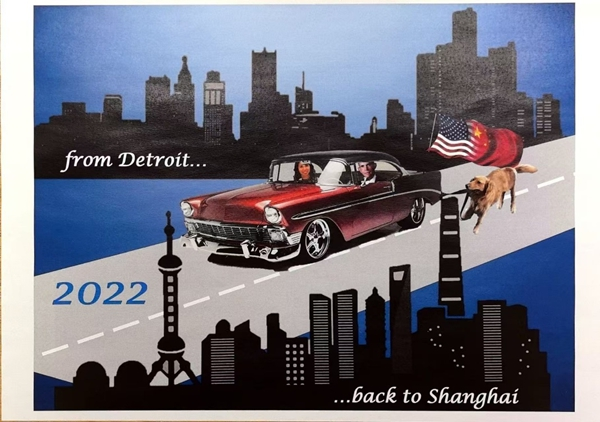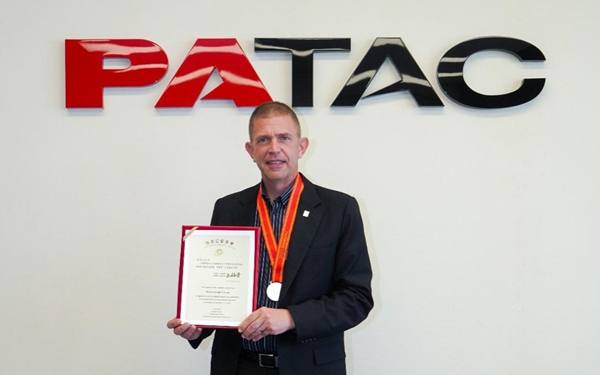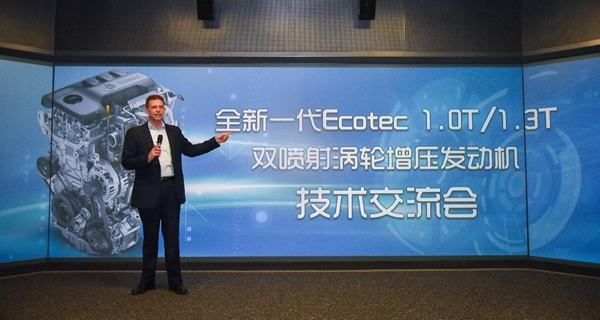
Profile: Michael Joseph Carman, born in 1968 in Waterloo, Iowa, USA, and a graduate of Kettering University. Michael joined General Motors in 1991, then moved to the Pan-Asia Technical Automotive Center (PATAC) in 2000, where he served as the Manager of Powertrain Calibration. In 2009, he became the Executive Director of PATAC’s Powertrain Department, and in 2016, the Vice President of General Motors’ Global Powertrain Division in China. By 2022, he was appointed as the General Manager and Director of PATAC.
In Michael 's office at the Pan-Asia Technical Automotive Center in Shanghai, there hangs a humorous cartoon. In the image, Michael and his wife drive a classic Cadillac from Detroit, the "Motor City," to Shanghai. At the back of the car, a golden retriever tugs at the vehicle as if calling out, “Hey! Why did you forget about me?”

A cartoon in Michael's office depicts his journey from Detroit to Shanghai.
"This golden retriever's name is Luna (meaning 'moon')," Michael tells the reporter. "We adopted her in Shanghai on New Year’s Day 2012. Before returning to Shanghai in 2022, considering her age, I decided to leave her in the U.S. She now lives with our daughter and is still full of energy."
For Michael, Luna is just one of many gifts Shanghai has given him. In 2000, he joined General Motors and SAIC Motor Corporation Limited’s joint venture, PATAC, becoming part of the Sino-American automotive technology collaboration. In 2023, to recognize his outstanding contributions to Shanghai, the municipal government awarded Michael the Shanghai Magnolia Silver Award. Michael said he was deeply honored: "This is not just a personal recognition, but a recognition of the entire team's work from Shanghai. Over the past 20 years, both Chinese and foreign employees at PATAC have shared one goal: to grow and strengthen our company."

In 2023, Michael received the Shanghai Magnolia Silver Award.
What Sparked the "Takeoff" of China's Automotive Industry?
In the exhibition hall of PATAC, there is a special display area: a showcase of exquisite car models, ranging from classic vintage cars of the 1950s to futuristic concept cars, neatly arranged in chronological order. Visitors can read a condensed history of automotive development here.
Michael, who has never left the automotive industry, has been involved in the design of many car models. When asked by Global People which car model he likes the most in the exhibition, Michael surprisingly pointed to a few early vehicles in the upper-right corner. Compared to the dazzling "descendants," these early cars seemed as if a chair and four wheels had been attached to a gasoline engine.
"I have many cars I like, but the ones I respect the most will always be these early cars," Michael explained. After a brief pause, he continued, "To me, the history of automotive development is more like an 'invention history.' These early cars may look primitive, but every small part of them carries an exciting story of innovation."
The automobile industry has repeatedly led industrial revolutions throughout history—from internal combustion engines and electric drive systems to assembly line technology, as well as rubber tires and cross screws. Cars have continuously served as a vehicle for technological progress.
"Today, the automotive industry is undergoing a new revolution, and I’ve witnessed the ‘takeoff’ of China’s automotive industry. This always reminds me of how car inventors, years ago, fought through many obstacles, starting with a simple part or a string of basic codes, gradually transforming the entire automotive industry system and ultimately bringing humanity a brand-new way of life. This is the spirit of innovation in the automotive industry," Michael said passionately.
In Michael’s view, the recent development of China’s automotive industry represents a growth across the entire sector: "China's automotive industry has a significant 'development curve.' It's like learning a new language. When you start with letters and words, progress is slow. But as your vocabulary grows and your grammar improves, your language skills will increase rapidly. The takeoff of China’s automotive industry follows the same principle. The electrification transformation of the automotive industry has further brought opportunities for the leap of China’s automotive sector."
According to data released by the China Passenger Car Association in July 2024, for the first time, the retail volume of new energy vehicles (NEVs) in China's passenger car market surpassed that of conventional fuel vehicles. By the end of 2024, China's NEV production has ranked first globally for nine consecutive years. Today, China’s automotive industry is undoubtedly the leader in the global NEV market.
Over the 17 years Michael has worked in China, he has personally participated in the rapid growth of China’s automotive industry and witnessed PATAC’s evolution into one of the most advanced automotive R&D centers in Asia. "My time working in China has been the highlight of my career."
Michael 's "China Adventure" started from an old garage in his childhood.
Michael’s “Chinese Adventure”
Long before joining PATAC, cars had already become an essential part of Michael 's life.
"My hometown, Iowa, is an agricultural state. I remember often riding in a car on country roads, looking at the farms and endless cornfields outside the window. That sense of leisure is something very hard to find in a big city."
Iowa is vast and sparsely populated, so cars naturally became a necessity for local residents.
"Back then, cars weren’t as digitalized as they are today. Many car problems could be solved by the owners themselves with a wrench and a screwdriver, so people formed a close bond with their cars. For Iowans, cars aren’t just a private property; they are family members lives, and we are responsible for their well-being. I grew up fixing cars in the garage with my family, changing oil, and that's where my interest in machinery began."
Michael said that the car that remains most deeply embedded in his childhood memories is a 1970 Chevrolet El Camino. He happily shows a photo of the car to the reporter. "As you can see, this is a very unique car, a cross between a sedan and a pickup truck. I bought it with money I earned from working as a part-time cook at a local restaurant. By the time my dad handed me the keys, it was already over 10 years old, and honestly, it was in poor condition. So I had to repair it often, but I didn’t mind at all. As an old saying from my hometown goes, you’ll never forget your first car."
After earning a degree in mechanical engineering from Kettering University, Michael quickly joined General Motors. For a car enthusiast like him, it was a dream come true. "I’ve always loved Cadillacs under GM's brand. I appreciate the design concept that combines technology and luxury. One of my favorite models years ago was the Cadillac CTS-V. It was a great car: comfortable, stylish, and fast."
With his strong technical expertise, Michael soon became a powertrain expert at General Motors. His connection with China began at that point.
Initially, Michael was somewhat apprehensive about working in China: "I had a friend working at Shanghai General Motors, and one day he came to me and said that PATAC was looking for a powertrain calibration expert and asked if I was interested. At the time, I had never even heard of PATAC, and I wasn’t prepared to work abroad, so I declined. But surprisingly, my friend was persistent and kept talking to me about life and opportunities in China. A month later, when he invited me again, I decided to take the 'big adventure' to China."

In 2022, Michael traveled in Yunnan.
Thus, in 2000, Michael arrived in China. PATAC had been established for just three years. "When I first came to Shanghai, my team only had four people, but I was very excited because I knew I could lead this team to grow gradually."
When Michael first came to Shanghai, private cars weren’t widespread in China. "The first question we asked during interviews was, 'Do you have a driver’s license?' Many of the applicants had never driven a car, but I still included them in the team because I saw their thirst for knowledge and passion for learning. I taught patiently the newcomers about automotive powertrains, and they learned quickly. Before long, we had an excellent technical team. I really enjoyed my time here, and when I was transferred back to the U.S. in 2003, I eagerly looked forward to returning to China."
In 2009, after gaining experience in several important positions at General Motors, Michael returned to PATAC as Executive Director of the Powertrain Department. Under his leadership, the center's independent R&D capabilities grew significantly, becoming one of the global centers for automotive engine development. In 2022, after nearly two years away from China, Michael returned to Shanghai as the General Manager and Director of PATAC.
"Build Cars with Open Doors"
During the interview, Michael took the reporter to a signature wall in the PATAC office lobby, where rectangular nameplates bearing the names of both Chinese and foreign employees were displayed.
Michael proudly said, "Although PATAC is a Sino-American joint venture, our team members come from not just China and the U.S., but from all over the world: Germany, India, Brazil, Australia. For them, working in a growing market like China and joining a thriving team like PATAC is an incredibly exciting opportunity."

In 2017, Michael hosted an engine technology exchange conference.
In Michael's view, for foreign companies to succeed in China, they must first adapt to the Chinese market and culture. "There are significant differences between automotive cultures in China and the United States. Take private cars, for example: in the U.S., people rely more on cars for daily travel, so many households own two or even more vehicles. In China, however, many people are more inclined to treat a car as a family transportation tool rather than a private one. Many Chinese commute using public transportation and only drive for family activities. This means Chinese consumers often want a car that can accommodate an entire family. This requires us to rethink the interior space design of vehicles and make our cars feel more like 'home.'"
During the process of adapting to the Chinese market, the Pan Asia Technical Automotive Center also "learned some lessons," which Michael sees as part of the company's growth. "These experiences have taught us how to better understand the needs of Chinese customers—what to add, what to reduce. Conducting thorough research and embracing trial and error is how we develop new cars for China, and it reflects our center's work culture."
2025 marks the 28th year since General Motors entered the Chinese market. Today, China is not only one of the company's most important markets but also a key production and research hub. Many General Motors vehicles designed and manufactured in China are no longer limited to the Chinese market but have already gone global. In Michael's view, the success of the Pan Asia Technical Automotive Center demonstrates the importance of technological and market exchange. "Over the past two decades, Sino-U.S. joint ventures have achieved incredible growth. We've established a mechanism for mutual learning and collaboration, ultimately fostering the shared development of Chinese and foreign enterprises."
When discussing the future of Sino-U.S. automotive technology cooperation, Michael believes that the growing international competitiveness of China's automotive industry can bring more new opportunities for collaboration. "Looking at the history of automotive development, we can see that international exchange has been the driving force behind the industry's progress. As Chinese automotive brands go global, there will be more opportunities and room for collaboration between the Chinese and U.S. automotive sectors. There's no reason for Sino-U.S. cooperation in the automotive field to come to a halt. As long as China's doors of openness remain open, we can discover more opportunities for 'win-win' cooperation."
It seems that Michael and the Pan Asia Technical Automotive Center's journey to design great cars for both China and the world has only just begun.
(Intern Hou Fangying contributed to this story.)
 Editor:Qiu Xiaochen
Editor:Qiu Xiaochen